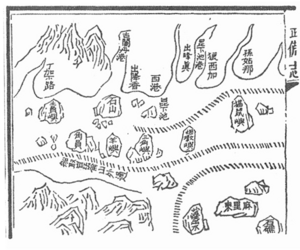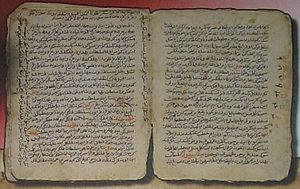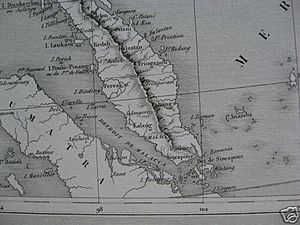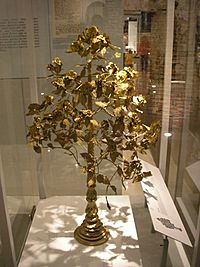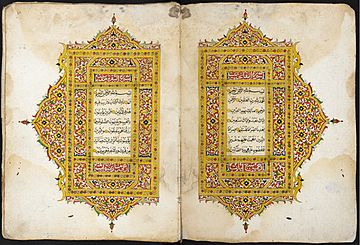Pattani Kingdom facts for kids
Quick facts for kids
The Sultanate of Patani
كسلطانن ڤطاني
Kesultanan Pattani |
|||||||||
|---|---|---|---|---|---|---|---|---|---|
| 1457?–1902 | |||||||||
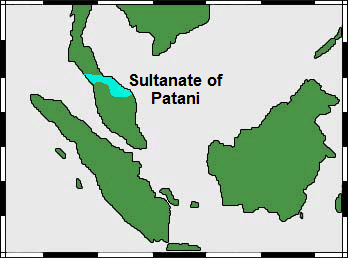
Map of the Sultanate of Patani
|
|||||||||
| Capital | Patani | ||||||||
| Common languages | Malay language (Classical Malay; court language Patani Malay; spoken daily language) |
||||||||
| Religion | Sunni Islam | ||||||||
| Government | Monarchy | ||||||||
| Historical era | Middle Ages | ||||||||
|
• Established
|
1457? | ||||||||
|
• Conquest by Siam in 1786, later followed by annexation
|
1902 | ||||||||
|
|||||||||
| Today part of | Thailand Malaysia |
||||||||
The Sultanate of Patani (also known as Pattani) was a powerful Malay kingdom in Southeast Asia. It was located in what is now Thailand (the provinces of Pattani, Yala, Narathiwat) and parts of northern Malaysia.
Patani had a "golden age" when four queens ruled one after another. This period started in 1584 with Raja Hijau (the Green Queen). During this time, Patani became very strong in its economy and military. It even fought off four attacks from the Siamese kingdom. However, by the late 1600s, Patani's power began to fade. Siam conquered it in 1786 and fully took control in 1902.
Contents
Early Kingdoms in Patani
Before Patani, there was an older kingdom called Langkasuka. It was a Hindu-Buddhist kingdom that started around 200 CE. Langkasuka was an important trading stop for ships from China, India, and other places. It was most successful in the 500s and 600s.
The main ruins of Langkasuka are found in Yarang District, about 15 kilometers from the sea. We don't know exactly how Langkasuka became Patani. Some stories say that Patani was founded by a ruler from Kota Mahligai, perhaps between 1350 and 1450. This early Patani was located in Keresik (Kru Se).
The Patani region had been under Thai control for some time. In the 1300s, the Sukhothai Kingdom and later the Ayutthaya kingdom controlled many smaller states like Patani. These states managed their own affairs but promised loyalty to the Thai king.
How Patani Got Its Name
There are two main stories about how Patani got its name.
The Mouse-Deer Story
One popular story says that "Patani" means "this beach" (pata ni in the local Malay language). A ruler was hunting and saw a beautiful white mouse-deer. It was as big as a goat! The mouse-deer then disappeared. When the ruler asked his men where it went, they replied, "Pata ni lah!" (This beach!). The ruler then ordered a town to be built there and named it Patani. The first ruler of Patani later became a Muslim and took the name Sultan Ismail Shah.
The Fisherman Story
Another story says the Patani kingdom was founded in the 1300s by a fisherman named Pak Tani (Father Tani). A king sent him to find a good place for a settlement along the coast. Pak Tani set up a successful fishing spot, and soon many other people joined him. The town grew into a busy trading center and kept his name. However, old historical writings from the 1600s and 1700s say this story is not true. They claim the kingdom was founded by a Sultan.
Early Days of the Sultanate
Patani was likely founded between 1350 and 1450. Its early history before 1500 is not very clear. The first ruler is said to be Sri Wangsa or his son Raja Intera. He became known as Phaya Tunakpa. He later converted to Islam and took the name Sultan Ismail Shah.
Patani probably became an Islamic kingdom in the mid-1400s. One story tells of a holy man named Sheikh Sa'id. He healed the king of a rare skin disease. After this, the king agreed to become a Muslim and took the name Sultan Ismail Shah. All his officials also converted. However, there is some evidence that some local people were already becoming Muslim before this. Traders from other Muslim areas had regular contact with Patani.
Patani became more important after the city of Malacca was captured by the Portuguese in 1511. Muslim traders then looked for other trading ports, and Patani became a popular choice. By the 1540s, many Portuguese traders had also settled in Patani.
Sultan Ismail Shah was followed by Sultan Mudhaffar Shah. In the 1500s, the kingdom of Burma attacked Ayutthaya (Siam). Sultan Mudhaffar Shah helped Burma in 1563 but died on his way back to Patani in 1564. His brother, Sultan Manzur Shah, then became the ruler.
After Manzur Shah died, Patani faced a time of political trouble and violence. Some rulers were even killed by their own relatives in fights for power.
The Four Queens of Patani
Raja Hijau and Patani's Golden Age
Raja Hijau (the Green Queen) became ruler in 1584. She was the first queen of Patani. She brought a lot of peace and stability to the country. During her 32-year reign, trade with other countries grew, and Patani became very rich. It also became a center for art and culture, known for its music, dance, and crafts.
Patani as a Trading Hub
Chinese merchants were very important in making Patani a major trading center. Traders from China, Malaysia, Siam, Persia, India, and Arabia all came to Patani. Later, Europeans like the Portuguese, Japanese, Dutch, and English also arrived. The Dutch East India Company and the English East India Company set up warehouses in Patani to trade. Patani was seen as a way for European traders to reach the Chinese market.
The Blue and Purple Queens
Raja Hijau died in 1616 and was followed by her sister, Raja Biru (the Blue Queen). Raja Biru convinced the nearby Kelantan Sultanate to join Patani.
After Raja Biru died in 1624, her younger sister, Raja Ungu (the Purple Queen), became ruler. Raja Ungu was more daring and challenged the Siamese kingdom. She stopped sending the Bunga mas (a golden flower tribute) to Siam. She also made an alliance with the Johor Sultanate. Siam attacked Patani in 1633–1634, but they could not conquer it.
The Yellow Queen and Patani's Decline
Raja Ungu died in 1634. Her daughter, Raja Kuning (the Yellow Queen), became the last of the four queens. The war with Siam had hurt Patani badly, and trade had dropped. Raja Kuning decided to be more friendly with the Siamese. In 1641, she visited the Ayutthaya court to improve relations.
By this time, the queen's power had weakened. Patani joined other states in a rebellion against Ayutthaya in 1646, but Ayutthaya put down the rebellion.
After Raja Kuning, other rulers from Kelantan took control of Patani. By the late 1600s, Patani was described as having few people and being a wild place. Most foreign traders left.
Siam Takes Control Again
In the 1700s, the Siamese kingdom of Ayutthaya faced another invasion from Burma. Ayutthaya was destroyed in 1767, and Patani declared itself fully independent.
However, a new Siamese king, Rama I, reunified Siam. In 1786, Siam sent an army to make Patani submit again. Patani was easily defeated. The city of Patani was destroyed, and a new town was built nearby.
Patani Under Bangkok's Rule
Patani became a tributary state to Siam again. This meant it had to pay tribute but could mostly rule itself. However, Patani tried to rebel several times. Because of this, Bangkok (the new capital of Siam) divided Patani into seven smaller states in the early 1800s.
Britain officially recognized Siam's ownership of Patani in 1826. The throne of Patani was empty for a few decades until 1842. A member of the Kelantan royal family then became the ruler. Patani still recognized Siam's authority and sent the bunga mas tribute.
In 1902, Siam wanted full control of Patani. They arrested and removed the last ruler of Patani when he refused their demands for changes in how Patani was run. This officially ended Patani as an independent state.
Rulers of Patani
Here are some of the important rulers of Patani:
Early Rulers (Inland Dynasty)
- Sultan Ismail Shah (died around 1530?): He is believed to be the first ruler to convert to Islam.
- Sultan Mudhaffar Shah (around 1530–1564): He died during an attack on Ayutthaya.
- Sultan Manzur Shah (1564–1572): Brother of Mudhaffar Shah.
- Raja Hijau (the Green Queen) (1584–1616): She brought great wealth and stability to Patani.
- Raja Biru (the Blue Queen) (1616–1624): Sister of Raja Hijau.
- Raja Ungu (the Purple Queen) (1624–1635): Sister of Raja Biru, she strongly opposed Siamese control.
- Raja Kuning (the Yellow Queen) (1635-1649/88): Daughter of Raja Ungu and the last queen of this dynasty.
Later Rulers (Kelantanese Dynasties)
After the Inland Dynasty, rulers from the Kelantan royal family took over.
- Sultan Muhammad (1771–1785): Ruled before Siam reasserted control.
- Sultan Abdul Kadir Kamaruddin Syah (1890–1902): The last ruler of Patani, who was removed by Siam in 1902.
Images for kids
See also
 In Spanish: Reino de Patani para niños
In Spanish: Reino de Patani para niños


